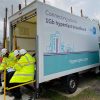Gigabit Broadband May Boost British Economy £51.4bn by 2025 UPDATE

A new study from Assembly Research, which was commissioned via the vested interests of Huawei, has forecast that the UK Government’s deployment of “gigabit-capable broadband” could provide £51.4bn gross value added to the economy in five years, growing to £68.8bn in 2030. But any delays could be very costly.
At present the Government plans to invest an extra £5bn (focused on helping those in the final 20% of hardest to reach premises) to ensure that 1Gbps capable broadband (via full fibre, cable / DOCSIS, 5G etc.) can reach every UK home by the end of 2025 (here). On top of that they’re also investing c.£500m to help 4G mobile operators expand their geographic coverage (likely to also benefit 5G deployments) to 95% by around the same date (here).
Admittedly the gigabit plan was previously laser focused upon fostering “full fibre” delivery, although that was more recently watered-down (here). However 2025 is still going to be a very difficult target to hit and that could be a problem. According to Assembly Research, a 12-month delay to achieving the 2025 goal of full gigabit coverage would mean the UK misses out on £9.7bn in productivity benefits, which rises to £28.7bn with a 2 year delay.
Advertisement
On the other hand it’s worth noting that Huawei has a vested interest in this as they’re a key supplier of both fixed line and mobile related broadband kit to UK telecoms operators and ISPs; this is something that has recently been cast into some doubt due to concerns over security and the adoption of a stricter policy by the UK Government (here). BT alone expects that decision to cost them £500m (here).
Nevertheless the new report, which sadly wasn’t attached to the press release and thus we’re unable to asses it in detail, has received support from Cityfibre, Openreach (BT), Three UK and Virgin Media.
Matthew Howett, Principal Analyst & Founder of Assembly, said:
“Access to reliable, future-proof digital infrastructure for all isn’t a luxury, but now accepted as a necessity whether it’s used for work, education or play. Increasing investment in key digital infrastructure will provide the bounce-back and economic recovery the UK will desperately need in the months and years ahead.”
Victor Zhang, Vice President of Huawei, said:
“We are committed to supporting our customers as they build better infrastructure for the UK. It’s now more vital than ever to focus on delivering the high-speed digital networks. Having been a key player and supplier to Britain’s telecoms sector since 2001, we stand ready to play our part in the industry’s future.”
As usual we must stress that trying to accurately gauge the economic impact of deploying faster broadband connectivity is notoriously difficult, not least since most businesses and consumers won’t be starting from a point of zero connectivity (the bulk will have already upgraded from a slower to faster broadband link).
Indeed any study that claims to show a huge economic boost should be taken with a pinch of salt as they’re often overly optimistic. On the other hand few would disagree that there does tend to be a strong positive relationship between broadband investment and growth. Likewise it’s often hard to predict what sort of innovations might occur once everybody has access to gigabit or better speeds.
Advertisement
On the other hand an earlier Ofcom study (here) noted that faster speeds tend to produce diminishing returns (e.g. key tasks like web browsing, email, banking and online shopping can only benefit so much from a faster connection), although such arguments will be irrelevant to those few who are still stuck in areas of super slow connectivity (i.e. where anything better than first generation ADSL would be welcome).
One other caveat of this report is that it’s largely based on the pre-COVID-19 picture and we don’t yet know how much the roll-out of gigabit broadband will be impacted as a result of the global health crisis (work is currently on-going to answer that question). In the meantime the report has proposed several recommendations to help UK policy-makers achieve the 2025 target.
Six Recommendations
1. Build on the significant progress there has been with commercial rollout and enabling regulatory environment and maintain this momentum;
2. Ensure sufficient funding exists for non-commercial areas if the whole country is to be covered and nobody is to be left behind;
3. A commitment to a technology neutral approach to reach the hardest parts of the country on time and in a cost-effective way;
4. Supporting market entry and expansion by alternative network operators, but recognising competition will vary by geography;
5. Making the cost of deployment as low as possible by addressing remaining barriers, which both increase costs and cause delays; and
6. Ensure the demand side is given more attention to encourage take-up and help lower investment risk.
Sadly the recommendations are frustratingly vague (it’s almost as if they don’t want to upset anybody..) and thus the Government, as well as Ofcom, could arguably answer all of the points by saying that they’re already doing them (in general terms, they are). As such an opportunity to get into specifics has been lost. For example, we would have liked to see a push for the business rates relief on new fibre to be extended.
Likewise it’s not enough to call for “sufficient funding” without also clarifying exactly what that means vs the existing commitment of £5bn and why. Sadly a list of vague recommendations, without at least some modelling to support their proposed impact, is about as useful as a teacup made of feathers. Not that we don’t applaud the effort, but it’s at the “must try harder” grading level.
Advertisement
UPDATE 28th April 2020
We’ve finally managed to get our hands on the full report, which still isn’t as detailed as we’d like but in the full recommendations (see below) they do cover wayleaves and business rates.
Six Recommendations (Full Version)
1. The focus on achieving the 2025 connectivity target should remain given how crucial connectivity is proving to be for UK citizens, and how it will underpin future economic growth and recovery.
The 2025 target for 100% coverage of gigabit-capable broadband was always an ambitious one, which the industry shared in supporting given the right regulatory and policy enablers were put in place. Current events have illustrated just how important it is to have reliable digital infrastructure for work, education and play and how even more important it is that this infrastructure meets the needs of future demands. The economic benefit of full-fibre and 5G is widely accepted, with significant contributions to productivity and GDP set to be realised if rollout is completed on time. Increasing investment in key digital infrastructure will provide the bounce-back and economic recovery the UK will desperately need in the months and years ahead.
2. Sufficient government subsidy and funding models must exist for non-commercial areas if the whole country is to be covered and nobody is to be left behind.
Access to reliable, future-proof digital infrastructure for all isn’t a luxury, but now accepted as a necessity. The £5bn commitment for the hardest to reach 20% and the £510m as part of the shared rural network are both welcome interventions, but remain modest in the sense of the overall £30bn the rollout is expected to cost. The effectiveness of this subsidy also depends on how the money is spent. Similar countries to the UK (such as France), are making available much more whether it’s pure subsidy or through extending voucher schemes to 5G fixed wireless access (FWA).
3. A commitment to the technology neutral approach will be needed to reach the hardest parts of the country on time and in a cost effective way.
Until recently there has been a fixation on specifying technology when it comes to broadband policy. Given the pace of technological change, and the suitability of some solutions over others when it comes to deployment, any gigabit capable technology should be considered – whether it’s cable, full-fibre or 5G FWA. To ignore this is not only counter to what end users care about, but also means the UK stands little to no chance of meeting the target for the whole country. Any delay to the roll-out of these networks risks not achieving the target and the anticipated benefits.
4. Investment and innovation should be pursued through competition with a regulatory framework that considers how this competition varies by geography.
The intense competition between providers has resulted in considerable benefit for end users in terms of faster speeds and lower prices. Encouraged by Ofcom and others, this rivalry has now spilled down to the infrastructure layer, where multiple infrastructure builders are now deploying competing full-fibre networks. It’s widely accepted that this has increased the pace and reach of deployment. However this model is unlikely to work for the whole of the country given different risk profiles and economics. Where competitive network build does not make sense, regulation should allow the appropriate recovery of costs.
5. Remaining barriers to deployment must be removed and promised planning reforms must be completed.
Encouraging progress has already been made on mandating full-fibre in new build homes, which if legislated this year will help speed up fibre deployment. However there’s still more to do – whether it’s extending business rates exemption for England and Wales as has been done in Scotland, or help with obtaining wayleaves – small but significant changes in policy will allow commercial deployments to reach more premises, sooner. Persistent barriers have been acutely felt by those rolling out 5G whether it’s with permitted development rights, out of date planning guidance or a mismatch between local and central government thinking.
6. The demand side must be given more attention to encourage takeup and help lower investment risk.
Much of the attention when it comes to broadband focuses on the supply – the pipes and the plumbing. For investors, demand matters because it’s a route to profitable returns on significant investments. The content, applications and services that consume the network matter as much as the fibre and spectrum used to make them possible. Government has an important role to play here – as a demand aggregator (moving more services online), helping those not currently connected understand the benefits of being so, and through more coordinated policymaking. Plans for a UK Industry 4.0, including smart cities need to better anticipate connectivity requirements to ensure the UK can compete with other leading economies.
Mark is a professional technology writer, IT consultant and computer engineer from Dorset (England), he also founded ISPreview in 1999 and enjoys analysing the latest telecoms and broadband developments. Find me on X (Twitter), Mastodon, Facebook, BlueSky, Threads.net and Linkedin.
« Cityfibre Start 1Gb Home Broadband Build in Bury St Edmunds























































>50% could upgrade to >100Mb now. What would the effect of that be?
Do your own research for once!
I really wish virgin would release some sort of rollout plan detailing what order they plan to enable docsis3.1.
I know there is no way they will, they would rather just keep us all in the dark, and I know dates can slip, bit even if it was undated and just had a general order of what regions were being done first….
Me too. It’s so inconsistent… first Reading or wherever it was went live, then Manchester a couple of weeks later, then 4-5 months later Birmingham and then nothing.
Also, they need to sort out this upstream DOCSIS 3.1 situation. Gimme 100 meg up!!!